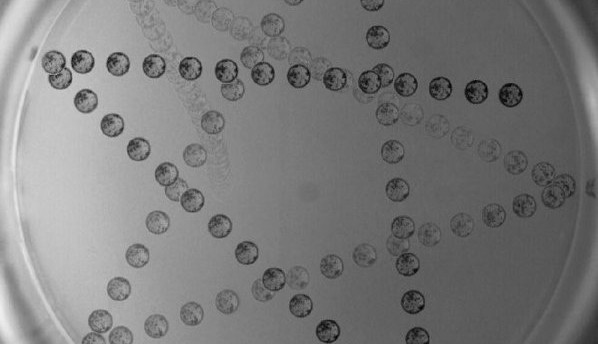Leidenfrost, but in reverse
on

A droplet of oil that is placed on a very cold liquid surface will, after a short time, start to move by itself, in straight lines and for many minutes, even after the droplet has frozen. This is really the opposite of what happens when a droplet of water moves over a hot surface and is known as the ‘Leidenfrost effect’.
Hot plate
Droplets that fall on a hot plate do not evaporate at a great rate, but are lifted by a kind of cushion made from their own vapour. This effect of these hovering droplets is also known as the Leidenfrost effect, and has been extensively researched since its discovery, in the eighteenth century, by its name giver Johann Gottlob Leidenfrost. But what happens to a droplet on an extremely cold surface? On a bath of liquid nitrogen (–196 °C) UT-researcher Anaïs Gauthier placed a droplet of silicon oil at room temperature. What happened? The droplet does not freeze immediately, but after a few seconds it spontaneously starts to move and with a constant speed, and continues to do so. This, by the way, also works with a droplet of ethanol (alcohol). Even when it finally does freeze, the droplet continues to me in straight lines, for tens of minutes. When it approaches the wall of the fluid container it bounces elastically.
Change in shape
In contrast to the normal Leidenfrost effect, it is not the droplet but the underlying liquid surface that changes shape. There forms a thin layer of vapour between the cold liquid and the relatively warm oil. This fact by itself does not explain why the droplet starts moving by itself, instead of freezing where it is. Something has to initiate it. From analysing camera images, simulations and mathematical models, it appears that the layer under the droplet is not symmetric. This asymmetry is the instigator for the movement: the speed can be satisfactorily predicted, using these models. There is no collision with the walls, the speed would then drop much faster. Between the wall and droplet there also forms a layer of vapour, so that it bounces back elastically.
Biological materials
Subsequent research should clarify what causes this asymmetry in the layer. An interesting question is also what happens when there are multiple droplets on the surface. The spontaneous movement of the droplets can be interesting for the freezing and transportation, without contamination, of biological materials, for example. The research was carried out by the Physics of Fluids group, part of the MESA+ Institute at the University of Twente. The paper ‘Self-propulsion of inverse Leidenfrost drops on a cryogenic bath’ has been published in the Proceedings of the National Academy of Sciences of the USA (PNAS).
Source: University of Twente
(Video: University of Twente)


Discussion (0 comments)